- Clone
- 5A6 (See other available formats)
- Regulatory Status
- RUO
- Other Names
- S5.7, CVID6, TSPAN28
- Isotype
- Mouse IgG1, κ
- Ave. Rating
- Submit a Review
- Product Citations
- publications
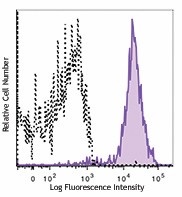
-

Human peripheral blood lymphocytes were stained with anti-human CD81 (clone 5A6) APC (filled histogram) or mouse IgG1, κ APC isotype control (open histogram).
| Cat # | Size | Price | Quantity Check Availability | Save | ||
|---|---|---|---|---|---|---|
| 349509 | 25 tests | 86€ | ||||
| 349510 | 100 tests | 247€ | ||||
CD81 is a 26 kD non-glycosylated member of the tetraspanin superfamily (TM4SF), also known as TAPA-1 (target of an antiproliferative antibody). CD81 is expressed on T and B cells, NK cells, monocytes, dendritic cells, thymocytes, endothelial cells, and fibroblasts. It also has low levels of expression on granulocytes. CD81 induces B cell adhesion via VLA-4 integrin and has been shown to play a role in early T cell development. CD81 associates with several other cell-surface proteins in a multimolecular complex, including CD19, CD21, CD20, CD37, CD53, and CD82 in B cells, and CD4, CD8, and CD82 in T cells.
Product DetailsProduct Details
- Verified Reactivity
- Human
- Reported Reactivity
- African Green, Baboon, Cynomolgus, Rhesus
- Antibody Type
- Monoclonal
- Host Species
- Mouse
- Immunogen
- Human OCI-LY8 cell line
- Formulation
- Phosphate-buffered solution, pH 7.2, containing 0.09% sodium azide and BSA (origin USA)
- Preparation
- The antibody was purified by affinity chromatography and conjugated with APC under optimal conditions.
- Concentration
- Lot-specific (to obtain lot-specific concentration and expiration, please enter the lot number in our Certificate of Analysis online tool.)
- Storage & Handling
- The antibody solution should be stored undiluted between 2°C and 8°C, and protected from prolonged exposure to light. Do not freeze.
- Application
-
FC - Quality tested
- Recommended Usage
-
Each lot of this antibody is quality control tested by immunofluorescent staining with flow cytometric analysis. For flow cytometric staining, the suggested use of this reagent is 5 µl per million cells in 100 µl staining volume or 5 µl per 100 µl of whole blood.
- Excitation Laser
-
Red Laser (633 nm)
- Application Notes
-
Additional reported applications (for the relevant formats) include: Western Blotting3 and immunoprecipitation2,3.
- Application References
-
- Van Zelm MC, et al. 2010. J. Clin. Invest. 120:1265.
- Oren R, et al. 1990. Mol. Cell. Biol. 8:4007. (IP)
- Clark K, et al. 2004. J. Biol. Chem. 279(19):19401. (IP, WB)
- Mochida K, et al. 2008. J. Virol. 13:6711.
- Rappa G, et al. 2014. Mol Cancer Res. 12:1840. PubMed
- Product Citations
-
- RRID
-
AB_2564020 (BioLegend Cat. No. 349509)
AB_2564021 (BioLegend Cat. No. 349510)
Antigen Details
- Structure
- 26 kD, type III transmembrane protein, member of the TM4SF tetraspanin family. Complexed with CD82, CD19, CD21, or CD4, CD8.
- Distribution
-
T cells, NK, monocytes, B cells, endothelial and epithelial cells, low on granulocytes.
- Function
- Regulates cell activation and growth and cell aggregation.
- Cell Type
- B cells, Endothelial cells, Epithelial cells, Monocytes, Neural Stem Cells, NK cells, T cells
- Biology Area
- Cell Biology, Immunology, Neuroscience, Neuroscience Cell Markers, Signal Transduction, Stem Cells, Transcription Factors
- Molecular Family
- Adhesion Molecules, CD Molecules
- Antigen References
-
- Van Zelm MC, et al. 2010. J. Clin. Invest. 120:1265.
- Fearon D, et al. 1995. Annu. Rev. Immunol. 13:127.
- Wright M, et al. 1994. Immunol. Today 15:588.
- Gene ID
- 975 View all products for this Gene ID
- UniProt
- View information about CD81 on UniProt.org
Related FAQs
Other Formats
View All CD81 Reagents Request Custom Conjugation| Description | Clone | Applications |
|---|---|---|
| Purified anti-human CD81 (TAPA-1) | 5A6 | FC,WB,IP |
| FITC anti-human CD81 (TAPA-1) | 5A6 | FC |
| PE anti-human CD81 (TAPA-1) | 5A6 | FC |
| PerCP/Cyanine5.5 anti-human CD81 (TAPA-1) | 5A6 | FC |
| APC anti-human CD81 (TAPA-1) | 5A6 | FC |
| PE/Cyanine7 anti-human CD81 (TAPA-1) | 5A6 | FC |
| Biotin anti-human CD81 (TAPA-1) | 5A6 | FC |
| Pacific Blue™ anti-human CD81 (TAPA-1) | 5A6 | FC |
| Alexa Fluor® 700 anti-human CD81 (TAPA-1) | 5A6 | FC |
| PE/Dazzle™ 594 anti-human CD81 (TAPA-1) | 5A6 | FC |
| TotalSeq™-A0373 anti-human CD81 (TAPA-1) | 5A6 | PG |
| TotalSeq™-C0373 anti-human CD81 (TAPA-1) | 5A6 | PG |
| TotalSeq™-B0373 anti-human CD81 (TAPA-1) | 5A6 | PG |
| TotalSeq™-D0373 anti-human CD81 (TAPA-1) | 5A6 | PG |
| FITC anti-human CD81 | 5A6 | FC |
| PE/Fire™ 640 anti-human CD81 (TAPA-1) | 5A6 | FC |
| Spark YG™ 581 anti-human CD81 (TAPA-1) | 5A6 | FC |
| Spark Blue™ 574 anti-human CD81 (TAPA-1) | 5A6 | FC |
| Brilliant Violet 785™ anti-human CD81 (TAPA-1) | 5A6 | FC |
| Spark Red™ 718 anti-human CD81 (TAPA-1) | 5A6 | FC |
Customers Also Purchased

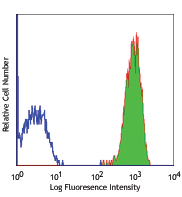
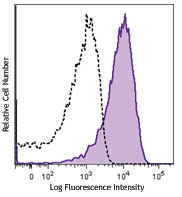
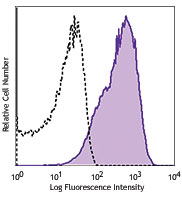
Compare Data Across All Formats
This data display is provided for general comparisons between formats.
Your actual data may vary due to variations in samples, target cells, instruments and their settings, staining conditions, and other factors.
If you need assistance with selecting the best format contact our expert technical support team.
-
Purified anti-human CD81 (TAPA-1)
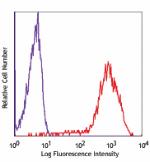
Human peripheral blood lymphocytes stained with purified CD8... -
FITC anti-human CD81 (TAPA-1)

Human peripheral blood lymphocytes stained with CD81 (5A6) F... -
PE anti-human CD81 (TAPA-1)

Human peripheral blood lymphocytes stained with CD81 (5A6) P... -
PerCP/Cyanine5.5 anti-human CD81 (TAPA-1)

Human peripheral blood lymphocytes were stained with CD81 (c... -
APC anti-human CD81 (TAPA-1)

Human peripheral blood lymphocytes were stained with anti-hu... -
PE/Cyanine7 anti-human CD81 (TAPA-1)

Human peripheral blood lymphocytes were stained with CD81 (c... -
Biotin anti-human CD81 (TAPA-1)
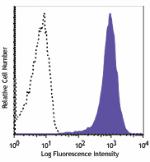
Human peripheral blood lymphocytes were stained with biotiny... -
Pacific Blue™ anti-human CD81 (TAPA-1)
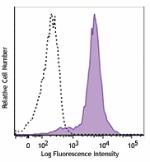
Human peripheral blood lymphocytes were stained with CD81 (c... -
Alexa Fluor® 700 anti-human CD81 (TAPA-1)
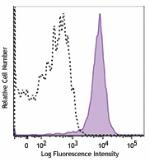
Human peripheral blood lymphocytes were stained with CD81 (c... -
PE/Dazzle™ 594 anti-human CD81 (TAPA-1)

Human peripheral blood lymphocytes were stained with anti-hu... -
TotalSeq™-A0373 anti-human CD81 (TAPA-1)
-
TotalSeq™-C0373 anti-human CD81 (TAPA-1)
-
TotalSeq™-B0373 anti-human CD81 (TAPA-1)
-
TotalSeq™-D0373 anti-human CD81 (TAPA-1)
-
FITC anti-human CD81
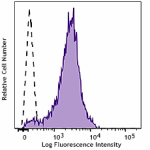
Typical results from human peripheral blood lymphocytes stai... -
PE/Fire™ 640 anti-human CD81 (TAPA-1)
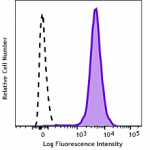
Human peripheral blood lymphocytes were stained with anti-hu... -
Spark YG™ 581 anti-human CD81 (TAPA-1)

Human peripheral blood lymphocytes were stained with anti-hu... -
Spark Blue™ 574 anti-human CD81 (TAPA-1)

Human peripheral blood lymphocytes were stained with anti-hu... -
Brilliant Violet 785™ anti-human CD81 (TAPA-1)

Human lysed whole blood was stained with anti-human CD81 (TA... -
Spark Red™ 718 anti-human CD81 (TAPA-1)

Human peripheral blood lymphocytes were stained with anti-hu...
 Login / Register
Login / Register 













Follow Us